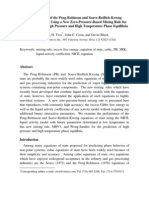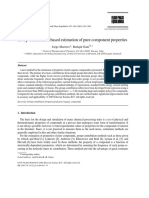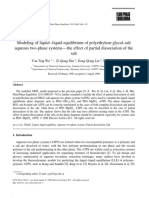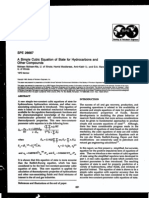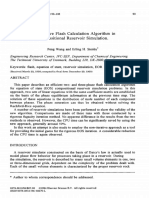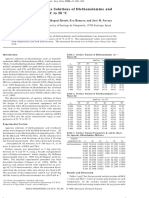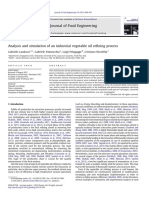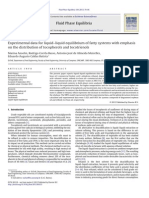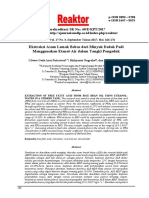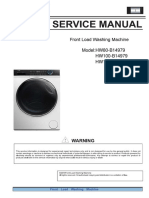Oliveira Et Al 2012
Oliveira Et Al 2012
Uploaded by
Daniela De Araujo SampaioCopyright:
Available Formats
Oliveira Et Al 2012
Oliveira Et Al 2012
Uploaded by
Daniela De Araujo SampaioCopyright
Available Formats
Share this document
Did you find this document useful?
Is this content inappropriate?
Copyright:
Available Formats
Oliveira Et Al 2012
Oliveira Et Al 2012
Uploaded by
Daniela De Araujo SampaioCopyright:
Available Formats
Liquidliquid equilibria for systems composed of rice bran oil and alcohol-rich
solvents: Application to extraction and deacidication of oil
Cssia M. Oliveira, Bruna R. Garavazo, Christianne E.C. Rodrigues
LES, Department of Food Engineering (ZEA-FZEA), University of So Paulo (USP), P.O. Box 23, 13635-900 Pirassununga, SP, Brazil
a r t i c l e i n f o
Article history:
Received 10 June 2011
Received in revised form 13 September
2011
Accepted 21 December 2011
Available online 29 December 2011
Keywords:
Vegetable oil
Liquidliquid extraction
Solidliquid extraction
Ethanol
Free fatty acids
UNIQUAC
a b s t r a c t
The liquidliquid equilibria of systems composed of rice bran oil, free fatty acids, ethanol and water were
investigated at temperatures ranging from 10 to 60 C. The results of the present study indicated that the
mutual solubility of the compounds decreased with an increase in the water content of the solvent and a
decrease in the temperature of the solution. The experimental data set was correlated by applying the
UNIQUAC model. The average variance between the experimental and calculated compositions was
0.35%, indicating that the model can accurately predict behavior of the compounds at different temper-
atures and degrees of hydration. The adjustment of interaction parameters enables both the simulation of
liquidliquid extractors for deacidication of vegetable oil and the prediction of phase compositions for
the oil and alcohol-rich phases that are generated during cooling of the stream exiting the extractor
(when using ethanol as the solvent).
2012 Elsevier Ltd. All rights reserved.
1. Introduction
Rice bran oil (RBO) is predominantly composed of oleic and lin-
oleic acids (37 and 36 mass%, respectively). This vegetable oil has
been considered to be a healthy oil due to its unsaponiable frac-
tion (up to 5 mass% of crude oil), which contains a unique antiox-
idant and nutraceutical complex. This complex is composed of
approximately 0.92.9% of gamma-oryzanol and 100
1000 mg kg
1
of tocopherols and tocotrienols (Orthoefer, 2005).
These minor compounds have been cited as powerful antioxidants
which can potentially prevent degenerative conditions (Orthoefer,
1996; MacCaskill and Zhang, 1999; Lerma-Garca et al., 2009).
RBO is commonly extracted from rice bran using hexane as the
solvent. Although hexane is highly stable and has a high capacity
for dissolving oil, it is considered to be a neurotoxin and is toxic
at high concentrations (Hammond et al., 2005). In addition, it is a
contributor to environmental pollution and originates from non-
renewable sources.
Recently, the oil industry has shown increased interest in alter-
native solvents because of environmental and safety concerns. Sev-
eral types of solvents have been proposed to replace hexane as the
extractant of vegetable oils: trichlorethylene, water (with or with-
out enzymes), halogenated hydrocarbons, aldehydes (furfural), ke-
tones, D-limonene, short-chain alcohols, and supercritical carbon
dioxide, among others (Johnson and Lusas, 1983; Rosenthal et al.,
1996; Liu and Mamidipally, 2005; Kuk and Hron, 1998; Proctor
and Bowen, 1996; Hu et al., 1996; Xu and Godber, 2000; Franco
et al., 2007, 2009; Monsoor and Proctor, 2005; Imsanguan et al.,
2008; Zigoneanu et al., 2008; Amarasinghe et al., 2009).
Ethanol has gained attention as a potential solvent for vegetable
oils and has been studied for oil extraction from soybeans (Arnold
and Choudhury, 1962; Rodrigues et al., 2010), corn (Moreau and
Hicks, 2005), rice bran oil (Rodrigues and Oliveira, 2010; Oliveira
et al., 2012) and cottonseed (Sineiro et al., 1998; Abraham et al.,
1988). After extraction at high temperature and subsequent
cooling, ethanol permits the formation of two liquid phases (an
alcohol-rich phase and an oil-rich phase), which is particularly
advantageous for subsequent processing (e.g., solvent recovery
and oil deacidication via liquidliquid extraction).
Several studies have shown that liquidliquid extraction using
ethanol can be used as an alternative route to obtaining vegetable
oils with acceptable levels of free fatty acids. This newprocess, per-
formed under milder conditions, avoids the formation of waste
products such as soaps, and it minimizes the loss of neutral oils
and nutraceutical compounds (Rodrigues et al., 2006; Cuevas
et al., 2009; Chiyoda et al., 2010).
In fact, it is possible to combine the extraction and deacid-
ication steps if ethanol is used as the solvent. Therefore, to
appropriately design a coupled process, it is necessary to study
the phase equilibrium properties of fatty systems at different
temperatures.
0260-8774/$ - see front matter 2012 Elsevier Ltd. All rights reserved.
doi:10.1016/j.jfoodeng.2011.12.027
Corresponding author. Tel.: +55 19 3565 4354; fax: +55 19 3565 4343.
E-mail address: chrisrodrigues@usp.br (C.E.C. Rodrigues).
Journal of Food Engineering 110 (2012) 418427
Contents lists available at SciVerse ScienceDirect
Journal of Food Engineering
j our nal homepage: www. el sevi er . com/ l ocat e/ j f oodeng
This paper presents the liquidliquid equilibrium (LLE) data for
systems containing degummed rice bran oil and ethanol at 10, 35,
and 60 C, and the experimental data were favorably correlated
using the UNIQUAC model. The adjustment of interaction parame-
ters enables simulation of liquidliquid extractors used in the
deacidication of vegetable oils, and it also permits prediction of
the phase compositions of the oily and alcohol-rich phases gener-
ated during cooling of the extractors outlet stream (when using
ethanol as a solvent).
Simulations of solidliquid extraction of rice bran oil using eth-
anol (with different levels of hydration) were performed at 50 and
80 C. The extract phase obtained from each solidliquid extrac-
tion was subjected to a cooling process that generates two liquid
phases, an oil-rich phase and an alcohol-rich phase. The composi-
tion of the aforementioned phases was determined by performing
ash calculations using the UNIQUAC model parameters presented
herein. Based on these calculations, it is possible to recover up to
98% of the solvent (ethanol and water) fed to the solidliquid
extractor when the extracted phase obtained at 80 C is cooled
to 25 C.
2. Experimental
2.1. Materials
Absolute ethanol (purity higher than 99.4%) was purchased
from Merck (Darmstadt, Germany), and aqueous solvents with
varying water content (6.34 0.03, 18.87 0.07, and 28.29 0.05
mass%) were prepared by diluting absolute ethanol with deionized
water (Millipore, Milli-Q, Bedford, MA, USA). Degummed rice bran
oil (RBO) (Irgovel/NutraCea, Brazil) was used in the equilibrium
experiments. This oil underwent the degumming process at the
renery after oil extraction and solvent stripping, and it could be
classied as semi-processed. It is important to emphasize that this
oil naturally exhibits acidity equal to the measured value, which
was determined as described in the Section 2.2.
2.2. Methods
To determine the fatty acid composition of the degummed rice
bran oil, gas chromatography detection of fatty acid methyl esters
(FAME) was performed according to a published method (AOCS,
1998). The gas chromatograph was equipped with a ame ioniza-
tion detector, an automatic injector (Shimadzu, model 2010 AF and
AOC 20i, Japan) and a Crossbond-PEG capillary column (RTx-Wax,
Restek, Bellefonte, PA, USA) with dimensions of 0.25 lm,
30 m 0.25 mm inner diameter. The following experimental con-
ditions were used for chromatography: the helium carrier gas ow
was set at 0.74 mL min
1
; the injection temperature was 250.0 C;
the column temperature was adjusted from 160.0 to 245.0 C,
using a ramp rate of 3 C min
1
; the detection temperature was
280.0 C; and the injection volume was 1.0 lL. The FAMEs were
identied by comparison with external standards purchased from
Supelco (Bellefonte, PA, USA), and the quantitation was accom-
plished using internal normalization.
RBO was mixed with solvent using oil:solvent mass ratios of
2:1, 1:1 and 1:2. Data from these mixtures were used to adjust
the UNIQUAC interaction parameters. Liquidliquid equilibrium
(LLE) data were determined using polypropylene centrifuge tubes
(50 mL) (Corning Inc.) according to published methodology (Rodri-
gues et al., 2006).
The components were weighed on an analytical balance with a
readability and accuracy of 0.0001 g (Adam, model AAA200, Milton
Keynes, UK). The tubes were vigorously stirred for at least 15 min,
centrifuged for 10 min at 4500g (Centrifuge Jouan model BR4i) and
then allowed to rest for 6 h in a thermostatic bath set at 10.0, 35.0
or 60.0 0.1 C (Tecnal, Brazil). After this treatment, the two
phases became optically clear and exhibited a well-dened inter-
face. The composition of both phases was then measured. The free
Nomenclature
A
0, ij
, A
0, ji
, A
1, ij
, A
1, ji
characteristic energy parameters of the
interactions between components i and j
C total number of compounds in the oil or in the fatty acid
D total number of data groups
E
1
extract stream from stage 1 in the solidliquid extractor
F feed stream in the solidliquid extractor
G total number of groups
k
i
distribution coefcient of compound i
K total number of components or pseudocompounds in
the data group m
M mass ow (kg h
1
)
M
AP
mass of alcoholic phase
M
OC
mass of the initial mixture
M
OP
mass of oil phase
M
i
average molar mass of the vegetable oil (or fatty acid)
N total number of tie lines in the data groups
OF(w) objective function of composition
q
0
i
area parameter of component i
Q
k
van der Waals area of group k
r
0
i
volume parameter of component i
R
k
van der Waals volume of group k
R
n
rafnate stream from stage n in the solidliquid
extractor
S solvent stream in the solidliquid extractor
T absolute temperature (K) or in (C)
v
j
k
number of group k in molecule j
x
j
mole fraction of compound or pseudocompound j
w
j
mass fraction of compound or pseudocompound j
Dw phase composition global deviation
Greek symbol
d relative deviation in the global mass balance
d
i
relative deviation of the mass balance for compound i
c
i
molar fraction-scale activity coefcient of compound i
c
w
i
mass fraction-scale activity coefcient of compound i
s
ji
, s
ij
UNIQUAC interaction parameters
r
w
OP
i;n;m
and r
w
AP
i;n;m
standard deviation of the compositions of the li-
quid phases
Subscripts
i, j component or pseudocomponent
k group
m group number
n tie line
s solvent
Superscripts
AP alcoholic phase
calc calculated value
exp experimental value
OP oil phase
C.M. Oliveira et al. / Journal of Food Engineering 110 (2012) 418427 419
fatty acid content (FFA), present naturally in the degummed oil and
in the alcohol and oil phases, was determined via titration (IUPAC,
1979) by an automatic burette (Metrohm, model Dosimat 715,
Herisan, Switzerland). The total solvent composition was deter-
mined by evaporating the oil to a constant mass in a vacuum oven
(inner absolute pressure = 126 mm Hg) at 60.0 C (Tecnal, Brazil).
The temperature and pressure used to determine the solvent com-
position were selected to prevent the degradation and/or volatili-
zation of fatty compounds in the samples. The drying period
required to completely remove the solvent from the oil or the alco-
hol-rich phase was determined by weighing the sample every
60 min until a constant mass was achieved. The water content
was determined by Karl Fischer titration with a KF Titrino titrator
(Metrohm, model 701, Herisan, Switzerland), according to the pro-
cedure described by AOCS (1998). The triacylglycerol content was
determined by difference.
In this study, all measurements were performed in triplicate,
and type-A standard uncertainties (Taylor and Kuyatt, 1994) in
the equilibrium data varied within the following ranges: 0.03
0.58 mass% for vegetable oil, 0.010.61 mass% for free fatty acids,
0.040.45 mass% for ethanol, and 0.020.49 mass% for water. In
the aforementioned data set, the lowest values were obtained from
the lowest concentrations.
To evaluate the validity of the results, the procedure developed
by Marcilla et al. (1995) was employed. The mass of each phase
(M
OP
and M
AP
) was calculated by applying a least-squares tting
to the experimental values of w
OP
i
and w
AP
i
.
Deviations (d) between the M
OC
(the mass of the initial mix-
ture) and the sum of M
OP
and M
AP
were calculated according to
Eq. (1):
d jM
OP
M
AP
M
OC
j=M
OC
100 1
In the equilibrium experiments, the relative deviation of the
mass balance for each compound i (d
i
) was calculated according
to Eq. (2):
d
i
jM
OP
w
OP
i
M
AP
w
AP
i
M
OC
w
OC
i
j=M
OC
w
OC
i
100 2
The relative deviation (d) of the results was less than 0.5%, indicat-
ing that the precision and reproducibility of the equilibrium data
was high (Rodrigues et al., 2005, 2007).
2.3. Modeling procedure
The experimental data were used to adjust the UNIQUAC binary
interaction parameters (Abrams and Prausnitz, 1975). Tradition-
ally, mole fractions are used with the UNIQUAC model, but mass
fractions provide a more convenient unit of measurement because
of the large differences in the molar masses of the components.
This procedural modication was rst used by Oishi and Prausnitz
(1978) for calculating the activity of a solvent in polymer solutions
using the UNIQUAC and UNIFAC methods. Several studies related
to fatty acid systems have employed this approach with the UNI-
QUAC model (Batista et al., 1999; Cuevas et al., 2009; Rodrigues
et al., 2005, 2006, 2007).
Since in the present case the iso-activity criterion was ex-
pressed in terms of mass fraction, the mass fraction-scale activity
coefcient c
w
i
should be related to the UNIQUAC activity coefcient
c
i
by the following equation:
c
w
i
c
i
M
i
K
j1
w
j
=M
j
_ _ _
3
The activity coefcient c
i
for the UNIQUAC model uses mass frac-
tions as a unit of concentration:
lnc
i
lnc
Comb
i
lnc
Res
i
4
lnc
Comb
i
lnW
0
i
lnw
i
=fM
i
1
fM
i
W
0
i
w
i
z
2
M
i
q
0
i
ln
h
0
i
W
0
i
z
2
M
i
q
0
i
1
W
0
i
h
i
0
_ _
5
Where,
f
K
j1
w
j
M
j
6
h
0
i
q
0
i
w
i
K
j1
q
0
j
w
j
; W
0
i
r
0
i
w
i
K
j1
r
0
j
w
j
7
and,
lnc
Res
i
M
i
q
0
i
1 ln
K
j1
h
0
j
s
ji
_ _
K
j1
h
0
i
s
ij
K
k1
h
0
k
s
kj
_ _ _ _ _
8
where,
s
ij
exp
A
ij
T
_ _
9
In this work, the data were correlated using the UNIQUAC equation
with temperature-dependent binary interaction parameters. The
temperature dependencies of A
ij
and A
ji
are given by Eqs. (10) and
(11):
A
ij
A
0;ij
A
1;ij
T 10
A
ji
A
0;ji
A
1;ji
T 11
where T is absolute temperature. The values of r
0
i
and q
0
i
(see Eq. (7)),
which represent volume and area parameters, were calculated
using Eq. (12), where R
k
and Q
k
are van der Waals parameters taken
from Magnussen et al. (1981),
r
0
i
1
M
i
C
j
x
j
G
k
m
j
k
R
k
; q
0
i
1
M
i
C
j
x
j
G
k
m
j
k
Q
k
12
Based on Eqs. (10) and (11), four adjustable parameters were
used for each pair of components (A
0
,
ij,
A
0
,
ji
, A
1
,
ij,
and A
1
,
ji
). The
parameters were estimated from the experimental data according
to the following procedure: a mixture of rice bran oil, free fatty
acids, ethanol and water was assumed to be pseudo-quaternary.
During the adjustment process, rice bran oil was considered to
be a single triacylglycerol with an average molar mass equal to
that of the oil, and the same approach was extended to the free
fatty acids. This approach is based on the assumption that differ-
ent triacylglycerols present in rice bran oil behave similarly in the
proposed liquidliquid system. Thus, the components of rice bran
oil can be adequately replaced by a pseudo-compound with aver-
age physicochemical properties. The same assumption is valid for
mixtures of free fatty acids. The aforementioned approach has
been evaluated by Lanza et al. (2008), who demonstrated its
accuracy.
The interaction parameter was estimated based on minimiza-
tion of the objective function of the composition (Eq. (13)), accord-
ing to the algorithm developed in the FORTRAN programing
language by Stragevitch et al. (1997):
OFw
D
m1
N
n1
K1
i1
w
OP;exp
i;n;m
w
OP;calc
i;n;m
r
w
OP
i;n;m
_ _
2
w
AP;exp
i;n;m
w
AP;calc
i;n;m
r
w
OP
i;n;m
_ _
2
_
_
_
_
;
13
The average deviations between the experimental and calculated
compositions of both phases were calculated according to Eq. (14):
420 C.M. Oliveira et al. / Journal of Food Engineering 110 (2012) 418427
Dw 100
N
n1
K
i1
w
OP;exp
i;n
w
OP;calc
i;n
_ _
2
w
AP;exp
i;n
w
AP;calc
i;n
_ _
2
_ _
2NK
_
14
2.4. Process simulation
2.4.1. Solid liquid extraction (SLE)
The rice bran oil extraction process was simulated by solving a
set of material balance and equilibrium equations. The ow rates
and concentrations of inert solids, solvent and rice bran oil in all
streams entering and leaving each stage were calculated. Within
the extraction unit, calculations were performed stage-to-stage,
which permitted determination of the number of stages required
to achieve a particular residual lipid value.
In particular, this study focuses on the mathematically simpler
resolution of an extractor for the purpose of determining extract
phases compositions (see stream E
1
in Fig. 1 that shows a sche-
matic representation of the countercurrent extraction). This ex-
tract phase is then cooled, generating two liquid phases (an oil-
rich phase and an alcohol-rich phase), which allows the recovery
of part of the solvent using a liquidliquid ash procedure.
For simulation of the solidliquid extractor, several design con-
siderations were used. Two inlet streams were fed to a countercur-
rent extractor working at 50.0 or 80.0 C and 101.3 kPa. One of the
inlet streams, the feed stream (F) was fed to the extractor at
stage 1. This inlet stream had a rice bran ow rate of 1000 kg h
1
.
The rice bran oil mass fraction was 0.20, the inert solid mass frac-
tion was 0.71 and the moisture content was 0.09. The other inlet
stream, fed to the extractor at stage n, only contained pure solvent
(S). Four solvents were studied: hexane, absolute ethanol, and hy-
drous ethanol (with 6 or 10 mass% water). Three levels of feed:sol-
vent mass ratios were considered (0.8, 1.0 and 1.2, respectively),
and the recovery of rice bran oil was xed at 97%.
The retention index (also called the liquid hold-up), which is
the amount of solution adhered to the solid matrix, was held
constant throughout the stages of the extraction equipment. For
simulations considering hexane as solvent, a retention index value
of 0.39 kg of liquid/kg of solid was considered according to Rittner
(1992) and Almeida et al. (2010).
In relation to ethanol, statistical models suggested by Rodrigues
and Oliveira (2010) and Oliveira et al. (Unpublished results) were
used to estimate the retention index and the level of water in the
extracted phase for process temperatures of 50.0 and 80.0 C,
respectively. The values of the retention index varied from 0.62
to 0.93 kg of liquid/kg of solid.
2.4.2. Cooling of the ethanolic extracts
As previously described, the extract phase obtained from each
solidliquid extraction was subjected to a cooling process that gen-
erates two liquid phases, an oil-rich phase (OP) and an alcohol-rich
phase (AP). The composition values of the alcohol-rich and oily
phases were obtained by performing ash calculations using the
UNIQUAC model parameters presented in this work. The solvent
content in the oily phase 100w
OP
34
and the oil content in the alco-
hol-rich phase 100w
AP
1
were calculated considering that the ex-
tract phase leaves the extractor at 50.0 or 80.0 C before being
cooled to one of three nal temperatures (35.0, 25.0 or 15.0 C).
3. Results
3.1. LLE experimental data and modeling
The fatty acid composition of rice bran oil is presented in
Table 1. From this fatty acid composition, the triacylglycerol
(TAG) composition of the oil was estimated using the procedure
proposed by Antoniosi Filho et al. (1995) (Table 2).
Among all possible isomers (with the same number of carbons
and of double bonds in the TAG molecule), the triacylglycerol with
the highest concentration was considered to be the primary com-
ponent of rice bran oil. Thus, to t the thermodynamic model, veg-
etable oil was treated as a single triacylglycerol with an average
molar mass equal to that of the oil. For this reason, the average
Fig. 1. Schematic representation of the countercurrent solidliquid extraction.
Table 1
Fatty acid composition of degummed rice bran oil.
Fatty acid Molar mass (g mol
1
) Composition
Symbol IUPAC name Notation
a
Mol (%) Mass (%)
M Tetradecanoic 14:0 228.38 2.54 2.10
P Hexadecanoic 16:0 256.43 20.38 18.94
S Octadecanoic 18:0 284.49 1.67 1.72
O Cis-octadec-9-enoic 18:1 282.47 36.49 37.36
Li Cis,cis-octadeca-9,12-dienoic 18:2 280.45 35.10 35.68
Le All-cis-octadeca-9,12,15-trienoic 18:3 278.44 2.00 2.02
A Eicosanoic 20:0 312.54 0.51 0.58
Ga Cis-11-eicosenoic 20:1 310.52 0.36 0.40
Be Docosanoic 22:0 340.59 0.42 0.52
Cis,cis-docosa-13, 16-dienoic 22:2 336.56 0.22 0.27
Lg Tetracosanoic 24:0 368.65 0.30 0.41
a
Notation of fatty acids, C:D, where C is the number of carbon atoms and D is the number of double bonds in the fatty acid.
C.M. Oliveira et al. / Journal of Food Engineering 110 (2012) 418427 421
molar mass of rice bran oil was calculated according to the esti-
mated triacylglycerol composition (Table 2).
The results shown in Tables 1 and 2 permit calculation of the
average molar mass of free fatty acids, naturally present in the
oil and of degummed rice bran oil. It was assumed that the free
acidity has the same fatty acid composition as the degummed
oil. The molar masses, volume and area parameters (Eq. (12)) are
presented in Table 3.
The rice bran oil had a free fatty acid content of
(4.90 0.02) mass%. It is important to emphasize that this calcu-
lated fatty acid level accounts for the average molar mass of free
fatty acids shown in Table 3.
Table 4 presents the composition of the alcohol-rich and oil-rich
phases of the pseudo-quaternary systems. The compositions of the
systems are reported as mass percentages.
Fig. 2 displays the experimental data points and tie lines calcu-
lated by the thermodynamic model (see dashed lines) for de-
gummed rice bran oil and solvent (i.e., ethanol with 6.34 0.03
and 18.87 0.07 mass% of water) at different temperatures
(10.0 0.1 and 35.0 0.1 C). The equilibrium diagrams are plotted
in rectangular coordinates. To represent the pseudoquaternary sys-
tem in rectangular coordinates, the ethanol and water solutions
were assumed to be a mixed solvent. In these gures, the mass
fraction composition of the vegetable oil can be obtained by
difference.
Analysis of Fig. 2a and b indicates that the mutual solubility of
the compounds was only slightly affected by temperature. In fact,
for the system using ethanol with 6 mass% water, the increase in
temperature does not seem to inuence either the solubility of
oil in the extract phase or the solubility of solvent in the oil phase.
This observation is in accordance with the results of Chiyoda et al.
(2010) and Cuevas et al. (2009) in studies related to soybean and
sunower seed oils, respectively. In those works, the authors men-
tioned that the vegetable oils, which contain a variety of nonpolar
compounds, can become solvated via hydrophobic hydration in
solvents with high water content. For systems containing water
solvent mixtures, the hydrophobic hydration of vegetable oil may
be associated with weak temperature effects on the solubility of
oil in the alcohol-rich phase.
On the other hand, Fig. 2b and c shows that the addition of
water to the solvent causes an enlargement of the biphasic region.
Water content reduces the solubility between the oil and solvent.
In the other words, the proportion of solvent in the oily phase
and the proportion of oil in the alcohol-rich phase decrease with
the addition of water, facilitating subsequent removal or recovery
of the solvent. The results shown in Fig. 2 indicate that the addition
of water reduces the solvents capacity for extracting free fatty
acids. This effect is suggested by inversion of the tie lines for sol-
vents with high water content. These data indicate that the ther-
modynamic model studied accurately describes the phase
compositions for this system.
Fig. 3 shows the distribution coefcient of free fatty acids, as a
function of temperature, for three different oil:solvent mass ratios
(2:1, 1:1 and 1:2). The distribution coefcient is dened by the
separation factor of the free fatty acids between the two liquid
phases at equilibrium. In this work, the distribution coefcient of
free fatty acids (k
2
) was calculated using mass fractions (according
to Eq. (15)), taking into account the differences in molar masses of
the compounds, as discussed in the Section 2.3.
k
2
w
AP
2
=w
OP
2
; 15
where w is the mass fraction and the superscripts OP and AP repre-
sent the oil-rich and alcohol-rich phases, respectively.
As shown in the Fig. 3, an increase in the water content reduced
the extractive capacity of the solvents. Moreover, an increase in
solution temperature did not affect the distribution of FFAs be-
tween the two phases, and the partition of FFAs between the two
liquid phases is not dependent on the mass fractions of oil and sol-
vent in the system. These comments are in accordance with a study
previously published by Reipert et al. (2011). In this work, the
authors conclude that the partition of free fatty acids between oil
and alcohol phases increases as the length of the carbon chain of
the FFA molecule decreases, but this distribution weakly depends
on temperature.
Finally, Fig. 3 also shows that the UNIQUAC model can reason-
ably describe the partitioning of FFAs.
Table 5 presents the adjusted parameters for the UNIQUAC
model. The deviations between the experimental and calculated
compositions in both phases were calculated according to Eq. (7)
and are shown in Table 6. For these systems, the thermodynamic
equation provided a reasonable description of the solvents solubil-
ity in the oil phase and of the oils solubility in the alcohol-rich
phase (Fig. 2). These results are in agreement with the overall devi-
ation values, which were small (Table 6).
3.2. Simulation results
Fig. 4 presents the number of theoretical stages necessary to
perform the rice bran oil extraction at a recovery rate of 97%. The
gure displays data for each solvent studied at 50 and 80 C. It is
important to note that the hexane calculations were performed
only for a process operated at 50 C.
The calculations indicated that the number of stages required
for extractions with ethanol is greater than the number of stages
Table 2
Probable triacylglycerol (TAG) composition of degummed rice bran oil.
Symbol of the main TAG
a
Molar mass (g mol
1
) Composition Mol (%)
MOP 805.32 1.19
MLiP 803.30 1.15
POP 833.37 4.90
PLiP 831.35 5.89
MOLi 829.34 2.53
LiLiM 827.32 1.22
POS 861.42 0.86
OOP 859.40 10.22
PLiO 857.39 18.23
LiLiP 855.37 9.80
PLiLe 853.37 1.00
OOS 887.46 1.24
OOO 885.44 6.30
OOLi 883.43 14.19
LiLiO 881.41 13.75
LiLiLi 879.43 5.62
LiLiLe 877.38 0.75
OLiA 913.52 0.62
LiLiA 911.50 0.51
a
See symbols related to fatty acids in Table 1. Groups with a total triacylglycerol
(TAG) composition lower than 0.5% were ignored.
Table 3
Average molar masses M, and structural parameters r
0
i
e q
0
i
.
Compound Molar mass (g mol
1
) r
0
i
b
q
0
i
c
Degummed rice bran oil (1) 863.52
a
0.04447 0.03606
Free fatty acids (2) 275.92 0.04504 0.03707
Ethanol (3) 46.07 0.05591 0.05618
Water (4) 18.02 0.05107 0.07771
a
Oil average molar mass calculated using the composition estimated according
to the procedure suggested by Antoniosi Filho et al. (1995).
b
Volume structural parameter.
c
Area structural parameter.
422 C.M. Oliveira et al. / Journal of Food Engineering 110 (2012) 418427
Table 4
Liquidliquid equilibrium data for the system degummed rice bran oil (1) + free fatty acids (2) + ethanol (3) + water (4), at different temperatures.
100w
4S
a
T (C) OC
b
OP
c
AP
d
100w
1
100w
2
100w
3
100w
4
100w
1
100w
2
100w
3
100w
4
100w
1
100w
2
100w
3
100w
4
0.62 10 47.61 2.45 49.55 0.39 79.34 2.13 18.40 0.13 10.58 2.69 85.86 0.87
31.72 1.64 66.17 0.47 82.32 1.36 16.19 0.13 8.36 1.72 89.21 0.71
63.31 3.06 33.32 0.31 77.78 2.58 19.42 0.22 12.38 3.71 82.74 1.17
6.34 10 47.59 2.45 46.70 3.26 86.29 2.37 10.22 1.12 3.74 2.47 87.13 6.66
31.79 1.54 62.37 4.30 88.16 1.50 9.89 0.45 3.18 1.57 88.85 6.40
62.88 3.30 31.56 2.26 84.99 3.32 11.13 0.56 4.47 3.10 85.25 7.18
35 47.58 2.45 46.71 3.26 86.31 2.47 10.72 0.50 4.56 2.39 86.69 6.36
31.68 1.63 62.39 4.30 87.64 1.59 10.28 0.49 3.70 1.66 88.32 6.32
63.29 3.26 31.21 2.24 84.68 3.26 11.39 0.67 4.49 3.11 85.44 6.96
60 47.51 2.51 46.76 3.22 86.06 2.54 10.92 0.48 4.49 2.47 86.71 6.33
31.69 1.68 62.40 4.23 87.18 1.74 10.62 0.46 3.57 1.65 88.51 6.27
63.23 3.34 31.22 2.21 84.73 3.41 11.27 0.59 5.29 3.33 84.48 6.90
18.87 10 47.55 2.43 40.50 9.52 89.91 3.24 6.19 0.66 1.09 1.51 77.62 19.78
32.70 1.67 53.19 12.44 91.45 2.53 5.42 0.60 0.95 1.18 78.63 19.24
62.56 3.20 27.68 6.56 89.57 3.58 6.16 0.69 1.28 1.75 75.91 21.06
35 47.52 2.30 40.63 9.55 89.63 3.08 6.63 0.66 1.30 1.33 78.02 19.35
31.43 1.52 54.35 12.70 90.68 2.34 6.36 0.62 1.00 1.08 79.36 18.56
63.55 3.07 26.98 6.40 89.05 3.63 6.61 0.71 1.45 1.65 76.49 20.41
60 47.67 2.30 40.51 9.52 89.59 3.15 6.33 0.93 1.41 1.35 78.60 18.64
31.81 1.54 54.02 12.63 90.20 2.29 5.94 1.57 1.13 1.17 79.27 18.43
63.49 3.07 27.02 6.42 88.99 3.66 6.49 0.86 1.71 1.71 76.91 19.67
28.29 35 47.57 2.30 36.32 13.81 90.54 3.57 5.25 0.64 0.51 0.77 68.99 29.73
31.42 1.96 47.26 19.36 90.23 4.09 5.13 0.55 0.08 0.77 70.95 28.20
63.46 3.20 23.74 9.60 90.40 4.35 4.57 0.68 0.51 0.84 67.23 31.42
60 47.60 2.30 36.30 13.80 90.27 3.69 5.09 0.95 0.72 0.59 73.88 24.81
31.49 1.97 47.25 19.29 90.14 3.85 5.32 0.69 0.49 0.71 72.63 26.17
63.47 3.19 23.85 9.49 90.48 4.22 4.70 0.60 0.41 0.88 67.14 31.57
a
100w
4S
= Water mass percentage in the solvent.
b
OC = overall composition.
c
OP = oil-rich phase.
d
AP = alcohol-rich phase.
C
.
M
.
O
l
i
v
e
i
r
a
e
t
a
l
.
/
J
o
u
r
n
a
l
o
f
F
o
o
d
E
n
g
i
n
e
e
r
i
n
g
1
1
0
(
2
0
1
2
)
4
1
8
4
2
7
4
2
3
required for extractions with hexane for all ratios of rice bran and
solvent. Also, the number of required stages increases as the water
content in the solvent increases. Increased extraction temperatures
result in a smaller number of theoretical stages.
The effects of solvent hydration and temperature are related not
only to the enhancement of oil solubility in the solvent but also to
the decrease of the retention index. This index is an engineering
variable that strongly affects the number of stages required to
perform the extraction (Kocatas and Cornell, 1954; Rittner, 1984;
Wisniak et al., 1987).
In previous studies related to the retention index, it was
observed that the values of this process variable increase as the
solvent hydration level increases. The effect of temperature is
prominent only for process temperatures above 60 C, mainly for
systems with low levels of water in the solvent (Rodrigues and
Oliveira, 2010; Oliveira et al., Unpublished results).
Fig. 2. System of degummed rice bran oil (1) + free fatty acids (2) + solvent [ethanol (3) + water (4)]: (j) experimental; ( ) calculated by the UNIQUAC model. (a)
6.34 0.03 mass% of water in the solvent, at 10.0 0.1 C; (b) 6.34 0.03 mass% of water in the solvent, at 35.0 0.1 C; (c) 18.87 0.07 mass% of water in the solvent, at
35.0 0.1 C.
Fig. 3. Distribution coefcients of free fatty acids (k
2
) as function of temperature, for different mass ratios of oil:solvent: (a) 2:1; (b) 1:1; (c) 1:2. Exp: (s)
100w
4S
= 0.62 0.07%; (j) 100w
4S
= 6.34 0.03%; (h) 100w
4S
= 18.87 0.07%; (.) 100w
4S
= 28.29 0.05%; ( ) calculated by the UNIQUAC model.
Table 5
UNIQUAC parameters.
Pair ij
a
A
b
0;ij
b
(K) A
b
0;ji
b
(K)
A
1;ij
A
1;ji
12 71.96 436.21 604.07 190.98
13 54.85 66.86 301.48 3.96
14 361.58 207.99 949.04 296.04
23 1759.30 843.05 1930.38 286.07
24 2464.30 28,398.0 2905.21 47,889.23
34 2107.90 400.44 2658.26 8.28
a
Degummed rice bran oil (1), free fatty acids (2), ethanol (3) and water (4).
b
A
0,ij
and A
0,ji
are energy parameters expressed in K.
Table 6
Mean deviations in phase compositions.
Temperature (C) 100w
4S
a
100Dw
10 0.62 0.73
6.34 0.53
18.87 0.22
35 6.34 0.22
18.87 0.16
28.29 0.29
60 6.34 0.54
18.87 0.35
28.29 0.26
Global deviation of the correlation 0.35
a
100w
4S
= Water mass percentage in the solvent.
424 C.M. Oliveira et al. / Journal of Food Engineering 110 (2012) 418427
Thus, it can be considered advantageous to use higher process
temperatures (see Fig. 4b), since under these conditions, the num-
ber of theoretical stages decreases due to the effect of temperature
on the retention index and on the solubility.
In addition to summarizing the composition of the extracted
phases from each solid to liquid extraction, Table 7 also shows
the mass ows of the outlet, rafnate (R
N
) and extract (E
1
) streams.
As described above, the extract phase was then cooled to generate
two liquid phases, an oil-rich phase and an alcohol-rich phase.
Fig. 5ac presents the solubility of the solvent (ethanol and
water) in the oil-rich phase 100w
OP
34
, and Fig. 5df shows the sol-
ubility of the neutral oil in the alcohol-rich phase 100w
AP
1
, respec-
tively, as a function of the chilling temperature. The data presented
in Fig. 5 correspond to a solidliquid extraction performed at 80 C.
According to the results summarized in Fig. 5, increased water
content in the solvent results in reduced mutual solubility at all
of the temperatures studied. At lower chilling temperatures, there
was a decrease in the amount of oil solubilized in the alcohol-rich
phase, and there was a decrease in the amount of solvent dissolved
in the oil-rich phase. The proportions of oil and solvent dissolved in
the respective phases also decreases with increases in the mass ra-
tio of rice bran to solvent fed to the extractor.
These results show that the submission of the stream E
1
to a li-
quidliquid ash procedure allows the separation of an oil-rich
phase, which will be 511% solvent (depending on the type of sol-
vent and the cooling temperature). For the solvent-rich phase, the
concentration of dissolved oil can vary from 0.5% to 6%. This cool-
ing procedure can save energy in the subsequent steps involving
solvent removal and recovery.
Isopropanol containing 9% water was tested as solvent in the
solidliquid extraction of cottonseed oil; the contents were subse-
quently cooled using a procedure by Harris et al. (1947). In this
work, the authors obtained an oil-rich phase containing 13% sol-
vent and an alcoholic-phase with 2.5% dissolved oil using a cooling
temperature of 30 C. There is good agreement between this work
and our results.
Fig. 6 presents the degree of solvent recovery after cooling the
process stream from 50 to 25 C (Fig. 6a) and from 80 to 25 C
(Fig. 6b), respectively. The degree of solvent recovery was calcu-
lated according to Eq. (16):
Recovery Degree % 100
w
AP
34
M
AP
w
E
1
34
M
E
1
; 16
where w is the mass fraction; subscripts 3 and 4 represent ethanol
and water, respectively; M is the mass ow (kg h
1
); and the super-
scripts E
1
and AP represent the extract phase from the solidliquid
extractor and alcohol-rich phase from the cooling process,
respectively.
With regard to the degree of solvent recovery, one can infer a
greater proportion of solvent relative to the bran in the solidliquid
extractor leads to increased solvent recovery during the cooling
process. Additionally, extractions performed at 80 C allow both
the use of fewer theoretical stages and higher levels of solvent
recovery. Fig. 6 also indicates that hydration of the solvent enables
Fig. 4. Number of theoretical stages in SLE as function of rice bran to solvent mass
ratio and solidliquid extraction temperature: (a) 50 C; (b) 80 C.
Table 7
Mass ows and compositions of the solidliquid extractor outlet stream.
Temperature
(C)
Solvent Feed to solvent mass
ratio
Rafnate phase ow rate
(kg h
1
)
Extract phase ow rate
(kg h
1
)
Composition of the
extract phase
a
100w
1
100w
3
100w
4
50 Hexane 0.8 1112.00 1138.00 17.05 82.95
1.0 1112.00 888.00 21.85 78.15
1.2 1112.00 721.33 26.89 73.11
50 Absolute ethanol 0.8 1408.64 841.36 23.06 74.37 2.57
1.0 1408.64 591.36 32.81 64.62 2.57
1.2 1408.64 424.69 45.68 51.75 2.57
Ethanol with 6 mass% of
water
0.8 1488.16 761.84 25.46 66.88 7.65
1.0 1488.16 511.84 37.90 54.45 7.65
1.2 1488.16 345.18 56.20 36.15 7.65
Ethanol with 10 mass% of
water
0.8 1544.00 706.00 27.48 61.32 11.20
1.0 1544.00 456.00 42.54 46.26 11.20
1.2 1544.00 289.33 67.05 21.75 11.20
80 Absolute ethanol 0.8 1297.35 952.65 20.36 77.67 1.97
1.0 1297.35 702.65 27.61 70.42 1.97
1.2 1297.35 535.98 36.20 61.84 1.97
Ethanol with 6 mass% of
water
0.8 1351.75 898.25 21.60 71.53 6.87
1.0 1351.75 648.25 29.93 63.20 6.87
1.2 1351.75 481.58 40.28 52.84 6.87
Ethanol with 10 mass% of
water
0.8 1418.25 831.76 23.32 66.14 10.53
1.0 1418.25 581.76 33.35 56.12 10.53
1.2 1418.25 415.09 46.74 42.73 10.53
a
Degummed rice bran oil (1), ethanol (3) and water (4).
C.M. Oliveira et al. / Journal of Food Engineering 110 (2012) 418427 425
a higher degree of recovery, and this effect is more prominent
when greater proportions of bran are used relative to the solvent.
4. Conclusions
The results presented in this paper improve the rice bran oil
extraction and deacidication processes that use ethanol as a sol-
vent. By knowing the distribution coefcient of the free fatty acids
as well as the mutual solubility of the compounds as function of
temperature, it is easier to properly design liquidliquid extractors
for oil deacidication and for solvent recovery.
The compositions of the alcohol-rich and oily phases were well
represented by the estimated UNIQUAC model parameters. The
calculated values for the liquidliquid equilibrium exhibited mean
deviations less than 0.73% when compared to the experimental
data for the systems of interest.
The estimated parameters are useful for predicting the compo-
sition of the liquid phases formed by cooling the liquid outlet
stream from the solidliquid extractor. Solvent recovery levels up
to 98% are feasible when the stream is cooled from 80 to 25 C.
For extraction of rice bran oil from the solid matrix using etha-
nol, the number of stages required for extractions with ethanol is
greater than that for extractions with hexane, and the number of
required stages increases as the water content in the alcoholic sol-
vent increases. Also, increasing the temperature of extraction pro-
cess ensures that similar oil recovery levels can be achieved with
fewer theoretical stages.
Acknowledgements
The authors wish to acknowledge FAPESP (Fundao de Amparo
Pesquisa do Estado de So Paulo 06/00565-4, 09/17855-3, 08/
53095-2, 07/05457-8), CNPq (Conselho Nacional de Desenvolvi-
mento Cientco e Tecnolgico), FINEP (Financiadora de Estudos
e Projetos) and CAPES (Coordenao de Aperfeioamento de Pes-
soal de Nvel Superior) for their nancial support.
References
Abrams, D.S., Prausnitz, J.M., 1975. Statistical thermodynamics of liquid mixtures: a
new expression for the excess gibbs energy of partly or completely miscible
systems. AIChE Journal 21, 116128.
Abraham, G., Hron, R.J., Koltun, S.P., 1988. Modeling the solvent extraction of
oilseeds. Journal of the American Oil Chemists Society 65 (1), 129135.
Almeida, R.L., Ravagnani, M.A.S.S., Modenes, A.N., 2010. Soybean oil extraction in
belt extractors with miscella recirculation. Chemical Engineering and
Processing 49, 9961005.
Amarasinghe, B.M.W.P.K., Kumarasiri, M.P.M., Gangodavilage, N.C., 2009. Effect of
method of stabilization on aqueous extraction of rice bran oil. Food and
Bioproducts Processing 87 (C2), 108114.
AOCS, 1998. Ofcial Methods and Recommended Practices of the AOCS, fth ed.
AOCS, Champaign.
Antoniosi Filho, N.R., Mendes, O.L., Lanas, F.M., 1995. Computer prediction of
triacylglycerol composition of vegetable oils by HRGC. Chromatographia 40 (9
10), 557562.
Fig. 5. Solvent solubility in oil phase (100w
OP
34
): (d) 100w
4S
= 0%; (j) 100w
4S
= 6 mass%; (h) 100w
4S
= 10 mass%; and neutral oil solubility in alcoholic phase (100w
OP
1
):
(s)100w
4S
= 0%; (h) 100w
4S
= 6 mass%; (h) 100w
4S
= 10 mass%, as function of chilling temperature for different feed to solvent mass ratios (F:S). (a) and (d) F:S = 0.8; (b) and
(e) F:S = 1.0; (c) and (f) F:S = 1.2.
Fig. 6. Recovery of solvent (%) as function of rice bran to solvent mass ratio and
solidliquid extraction temperature: (a) 50 C; (b) 80 C.
426 C.M. Oliveira et al. / Journal of Food Engineering 110 (2012) 418427
Arnold, L.K., Choudhury, R.B.R., 1962. Ethanol extraction of soybean oil. Journal of
the American Oil Chemists Society 39 (8), 379380.
Batista, E., Monnerat, S., Kato, K., Stragevitch, L., Meirelles, A.J.A., 1999. Liquidliquid
equilibrium for systems of canola oil, oleic acid and short-chain alcohols.
Journal of Chemical and Engineering Data 44, 13601364.
Chiyoda, C., Peixoto, E.C.D., Meirelles, A.J.A., Rodrigues, C.E.C., 2010. Liquid-liquid
equilibria for systems composed of rened soybean oil, free fatty acids, ethanol,
and water at different temperatures. Fluid Phase Equilibria 299 (1), 141147.
Cuevas, M.S., Rodrigues, C.E.C., Meirelles, A.J.A., 2009. Effect of solvent hydration
and temperature in the deacidication process of sunower oil using ethanol.
Journal of Food Engineering 95 (2), 291297.
Franco, D., Sineiro, J., Nez, M.J., 2009. Analysis of variables and modeling of
gevuina avellana oil extraction with ethanol near azeotrope conditions. Journal
of Food Process Engineering 32 (5), 664681.
Franco, D., Sineiro, J., Pinelo, M., Nez, M.J., 2007. Ethanolic extraction of rosa
rubiginosa soluble substances: oil solubility equilibria and kinetic studies.
Journal of Food Engineering 79 (1), 150157.
Hammond, E.G., Johnson, L.A., Su, C., Wang, T., White, P.J., 2005. Soybean oil. In:
Shahidi, F. (Ed.), Baileys Industrial Oil and Fat Products. John Wiley and Sons,
New Jersey, pp. 577653.
Harris, W.D., Bishop, F.F., Lyman, C.M., Helpert, R., 1947. Isopropanol as a solvent for
extraction of cottonseed oil. 1. Preliminary investigations. Journal of the
American Oil Chemists Society 24 (11), 370375.
Hu, W., Wells, J.H., Shin, T., Godber, J.S., 1996. Comparison of isopropanol and
hexane for extraction of vitamin E and oryzanols from stabilized rice bran.
Journal of the American Oil Chemists Society 73 (12), 16531656.
Imsanguan, P., Roaysubtawee, A., Borirak, R., Pongamphai, S., Douglas, S., Douglas,
P.L., 2008. Extraction of alpha-tocopherol and gamma-oryzanol from rice bran.
LWT-Food Science and Technology 41 (8), 14171424.
IUPAC., 1979. In: Paquot, C. (Ed.), Standard Methods for the Analysis of Oils Fats and
Derivatives, sixth ed. Pergamon Press, Oxford (part 1, sections I and II).
Johnson, L.A., Lusas, E.W., 1983. Comparison of alternative solvents for oils
extraction. Journal of the American Oil Chemists Society 60 (2), 229242.
Kocatas, B.M., Cornell, D., 1954. Holdup and residual saturation of hexane in
gravity-drained soybean ake beds. Industrial and Engineering Chemistry 46
(6), 12191224.
Kuk, M.S., Hron, R.J., 1998. Cottonseed extraction with new solvent system:
isohexane and alcohol mixtures. Journal of the American Oil Chemists Society
75 (8), 927930.
Lanza, M., Borges Neto, W., Batista, E., Poppi, R.J., Meirelles, A.J.A., 2008. Liquid
liquid equilibrium data for reactional systems of ethanolysis at 298.3 K. Journal
of Chemical and Engineering Data 53 (1), 515.
Lerma-Garca, M.J., Herrero-Martnez, J.M., Sim-Alfonso, E.F., Mendona, C.R.B.,
Ramis-Ramos, G., 2009. Composition, industrial processing and applications of
rice bran c-oryzanol. Food Chemistry 115 (2), 389404.
Liu, S.X., Mamidipally, P.K., 2005. Quality comparison of rice bran oil extracted with
D-limonene and hexane. Cereal Chemistry 82 (2), 209215.
MacCaskill, D.R., Zhang, F., 1999. Use of rice bran oil in foods. Food Technology 53
(2), 5052.
Magnussen, T., Rasmussen, P., Fredenslund, A., 1981. UNIFAC parameter table for
prediction of liquidliquid equilibria. Industrial and Engineering Chemistry
Process Design and Development 20 (2), 331339.
Marcilla, A., Ruiz, F., Garca, A.N., 1995. Liquidliquidsolid equilibria of the
quaternary system waterethanolacetonesodium chloride at 25 C. Fluid
Phase Equilibria 112 (2), 273289.
Monsoor, M.A., Proctor, A., 2005. Tocopherol, tocotrienol, and oryzanol content of
rice bran aqueous extracts. Journal of the American Oil Chemists Society 82 (6),
463464.
Moreau, R.A., Hicks, K.B., 2005. The composition of corn oil obtained by the alcohol
extraction of ground corn. Journal of the American Oil Chemists Society 82 (11),
809815.
Oishi, T., Prausnitz, J.M., 1978. Estimation of solvent activities in polymer solutions
using a group-contribution method. Industrial & Engineering Chemistry Process
Design and Development 17 (3), 333339.
Oliveira, R., Aracava, K.K., Gonalves, C.B., Rodrigues, C.E.C., Unpublished results.
Ethanolic extraction of rice oil: effects of processing parameters on physical
properties and retention index.
Oliveira, R., Oliveira, V., Aracava, K.K., Rodrigues, C.E.C., 2012. Effects of the
extraction conditions on the yield and composition of rice bran oil extracted
with ethanol - a response surface approach. Food and Bioproducts Processing 90
(1), 2231.
Orthoefer, F.T., 1996. Rice bran oil: healthy lipid source. Food Technology 50 (12),
6264.
Orthoefer, F.T., 2005. Rice bran oil. In: Shahidi, F. (Ed.), Baileys Industrial Oil and Fat
Products. John Wiley and Sons, New Jersey, pp. 465489.
Proctor, A., Bowen, D.J., 1996. Ambient-temperature extraction of rice bran oil with
hexane and isopropanol. Journal of the American Oil Chemists Society 73 (6),
811813.
Reipert, E.C.D., Rodrigues, C.E.C., Meirelles, A.J.A., 2011. Phase equilibria study of
systems composed of rened babassu oil, lauric acid, ethanol, and water at
303.2 K. The Journal of Chemical Thermodynamics 43, 17841790.
Rittner, H., 1984. Conditioning of oil-bearing materials for solvent extraction by
extrusion. Journal of the American Oil Chemists Society 61 (7), 12001203.
Rittner, H., 1992. Extraction of vegetable oils with ethyl alcohol. Olagineaux 47 (1),
2942.
Rodrigues, C.E.C., Onoyama, M.M., Meirelles, A.J.A., 2006. Optimization of the rice
bran oil deacidication process by liquidliquid extraction. Journal of Food
Engineering 73 (4), 370378.
Rodrigues, C.E.C., Reipert, E.C.D., Souza, A.F., Pessa Filho, P.A., Meirelles, A.J.A.,
2005. Equilibrium data for systems composed by cottonseed oil + commercial
linoleic acid + ethanol + water + tocopherols at 298.2 K. Fluid Phase Equilibria
238 (2), 193203.
Rodrigues, C.E.C., Peixoto, E.C.D., Meirelles, A.J.A., 2007. Phase equilibrium for
systems composed by rened soybean oil plus commercial linoleic acid plus
ethanol plus water, at 323.2 K. Fluid Phase Equilibria 261 (12), 122128.
Rodrigues, C.E.C., Oliveira, R., 2010. Response surface methodology applied to the
analysis of rice bran oil extraction process with ethanol. International Journal of
Food Science and Technology 45 (4), 813820.
Rodrigues, C.E.C., Aracava, K.K., Abreu, F.N., 2010. Thermodynamic and statistical
analysis of soybean oil extraction process using renewable solvent.
International Journal of Food Science and Technology 45 (11), 24072414.
Rosenthal, A., Pyle, D.L., Niranjan, K., 1996. Aqueous and enzymatic processes for
edible oil extraction. Enzyme And Microbial Technology 19 (6), 402420.
Sineiro, J., Domnguez, H., Nez, M.J., Lema, J.M., 1998. Ethanolic extraction of
sunower oil in a pulsing extractor. Journal of the American Oil Chemists
Society 75 (6), 753754.
Stragevitch, L., dvila, S.G., 1997. Application of a generalized maximum likelihood
method in the reduction of multicomponent liquidliquid equilibrium data.
Brazilian Journal of Chemical Engineering 14 (1), 4152.
Taylor, B.N., Kuyatt, C.E., 1994. Guidelines for the Evaluation and Expression of
Uncertainty in NIST Measurement Results (NIST Technical Note 1297). NIST,
Gaithersburg.
Wisniak, J., Hillet, J., Katz, O., 1987. Holdup and extraction characteristics of jojoba
meal. Journal of the American Oil Chemists Society 64 (9), 13521354.
Xu, Z., Godber, J.S., 2000. Comparison of supercritical uid and solvent extraction
methods in extracting c-oryzanol from rice bran. Journal of the American Oil
Chemists Society 77 (5), 547551.
Zigoneanu, I.G., Wilhams, L., Xu, Z., Sabliov, C.M., 2008. Determination of
antioxidant components in rice bran oil extracted by microwave-assisted
method. Bioresource Technology 99 (11), 49104918.
C.M. Oliveira et al. / Journal of Food Engineering 110 (2012) 418427 427
You might also like
- Assessment Point 1Document6 pagesAssessment Point 1AmbOladimejiMosesOkunribido100% (1)
- GE FKG1N - Brochure-EnDocument2 pagesGE FKG1N - Brochure-EnHassan_haNo ratings yet
- 2012 - A Review of Research On The Kalina Cycle PDFDocument10 pages2012 - A Review of Research On The Kalina Cycle PDFWilliam ChangNo ratings yet
- A Comparison of The Peng-Robinson and Soave-Redlich-Kwong Equations of StateDocument18 pagesA Comparison of The Peng-Robinson and Soave-Redlich-Kwong Equations of StateVettidog100% (1)
- CP Prediction Pure HydrocarbonsDocument33 pagesCP Prediction Pure HydrocarbonsjohnNo ratings yet
- Liquid-Liquid Equilibrium Data and Thermophysical Properties Forternary Systems Composed of Water, Acetic Acid and Different SolventsDocument16 pagesLiquid-Liquid Equilibrium Data and Thermophysical Properties Forternary Systems Composed of Water, Acetic Acid and Different SolventsMaria Paula BuitragoNo ratings yet
- Flash Calc 152Document8 pagesFlash Calc 152Mohamed MamdouhNo ratings yet
- Marrero and Gani 2001Document26 pagesMarrero and Gani 2001Jillian PeteNo ratings yet
- Thermodynamics of Acetona-Chloroform MixturesDocument27 pagesThermodynamics of Acetona-Chloroform MixturesYli S'cNo ratings yet
- Applied Energy: Johannes Schmidt, Sylvain Leduc, Erik Dotzauer, Georg Kindermann, Erwin SchmidDocument14 pagesApplied Energy: Johannes Schmidt, Sylvain Leduc, Erik Dotzauer, Georg Kindermann, Erwin SchmidgeoNo ratings yet
- Improved Steam Condenser Gas Removal SystemDocument7 pagesImproved Steam Condenser Gas Removal Systemtfernandes.x18No ratings yet
- Elsevier Science Publishers B.V.. Amsterdam - Printed in The NetherlandsDocument16 pagesElsevier Science Publishers B.V.. Amsterdam - Printed in The NetherlandssonsdoedenNo ratings yet
- Computation of Phase and Chemical Equilibrium IIDocument8 pagesComputation of Phase and Chemical Equilibrium IIThou KanshieNo ratings yet
- 0378 3812 2889 2980369 3 PDFDocument12 pages0378 3812 2889 2980369 3 PDFsaeedt538No ratings yet
- Liquid Liquid Column Drop: Spray Holdup, and Continuous Phase Mass TransferDocument6 pagesLiquid Liquid Column Drop: Spray Holdup, and Continuous Phase Mass TransferBastien DautricheNo ratings yet
- An Equation-Of-State-Based Viscosity Model For Non-Ideal Liquid MixturesDocument16 pagesAn Equation-Of-State-Based Viscosity Model For Non-Ideal Liquid MixturesDavid ReyesNo ratings yet
- A MODIFIED PENG-ROBINSON EQUATION OF STATE FOR - ELV - 20519 - FTP PDFDocument12 pagesA MODIFIED PENG-ROBINSON EQUATION OF STATE FOR - ELV - 20519 - FTP PDFLuiz Roberto TerronNo ratings yet
- Polyethylene Glycol-Salt PDFDocument14 pagesPolyethylene Glycol-Salt PDFlauraNo ratings yet
- OF TO: Oxidation Acetaldehyde Acetic Acid In1 A Sparger ReactorDocument8 pagesOF TO: Oxidation Acetaldehyde Acetic Acid In1 A Sparger Reactorarpit gargNo ratings yet
- A Comprehensive Comparison of Mixing Rules For Calculation of Phase Equilibria in Complex SystemsDocument8 pagesA Comprehensive Comparison of Mixing Rules For Calculation of Phase Equilibria in Complex Systemsmurdanetap957No ratings yet
- A Method To Estimate The Patel-Teja Equation of State ConstantsDocument7 pagesA Method To Estimate The Patel-Teja Equation of State Constants1940LaSalleNo ratings yet
- ThermodynamicsDocument2 pagesThermodynamicsvinovictory8571No ratings yet
- Development of A Generalized Quartic Equation of State For Pure FDocument171 pagesDevelopment of A Generalized Quartic Equation of State For Pure FFelipe Miguel Sánchez ClementsNo ratings yet
- Milk Process SimulationDocument7 pagesMilk Process SimulationClaudia Ramirez100% (1)
- A Comprehensive Framework For Surfactant Selection and Design For Emulsion Based Chemical Product Design PDFDocument12 pagesA Comprehensive Framework For Surfactant Selection and Design For Emulsion Based Chemical Product Design PDFArley NovaNo ratings yet
- Improvement in Patel Teja Eqn of StatesDocument10 pagesImprovement in Patel Teja Eqn of StatesSumukh VermaNo ratings yet
- Ijee 1157Document5 pagesIjee 1157Mike PerkinsNo ratings yet
- Co 2Document9 pagesCo 2Farah Talib Al-sudaniNo ratings yet
- A Simple CEOSDocument9 pagesA Simple CEOSnghiabactramyNo ratings yet
- Simulation and Analysis of A Single-Effect Thermal Vapor-CompressionDocument9 pagesSimulation and Analysis of A Single-Effect Thermal Vapor-CompressionPeng TerNo ratings yet
- Propiedades Del ArgonDocument11 pagesPropiedades Del ArgonJuanVelaverdeNolazcoSalasNo ratings yet
- Urea PhenolDocument21 pagesUrea PhenolMarthaLuceroPerezNo ratings yet
- Flash Calc 3Document16 pagesFlash Calc 3Mohamed MamdouhNo ratings yet
- Combining Pinch and Exergy Analysis ForDocument13 pagesCombining Pinch and Exergy Analysis Forasad0071No ratings yet
- Equations of State PDFDocument3 pagesEquations of State PDFRoozbeh PNo ratings yet
- Phase Equilibria Gernert Et Al Fpe 2014Document10 pagesPhase Equilibria Gernert Et Al Fpe 2014RoseJauneNo ratings yet
- Sarica - 2011 - International Journal of Multiphase Flow Comment On Correlation of Entrainment For Annular Flow in Horizontal Pipes 'Document2 pagesSarica - 2011 - International Journal of Multiphase Flow Comment On Correlation of Entrainment For Annular Flow in Horizontal Pipes 'John DoeNo ratings yet
- Surface Tension of Aqueous Solutions of Diethanolamine and Triethanolamine From 25 °C To 50 °CDocument3 pagesSurface Tension of Aqueous Solutions of Diethanolamine and Triethanolamine From 25 °C To 50 °C1940LaSalleNo ratings yet
- Computation of Phase and Chemical Equilibrium IDocument9 pagesComputation of Phase and Chemical Equilibrium IThou KanshieNo ratings yet
- An Empirical Correlation of Second Ria Coefficients: Chem. Sci., 22,766 Alche J., 12, 1202 (1966)Document10 pagesAn Empirical Correlation of Second Ria Coefficients: Chem. Sci., 22,766 Alche J., 12, 1202 (1966)rlonardo053643No ratings yet
- Isobaric Vapor-Liquid Equilibrium For Binary System of Methanol and AcetonitrileDocument4 pagesIsobaric Vapor-Liquid Equilibrium For Binary System of Methanol and AcetonitrileAlejandra Rodríguez MorenoNo ratings yet
- HeyhhuDocument10 pagesHeyhhuAbhijeet JhankalNo ratings yet
- A Mathematical Model For Equilibrium Solubility of Hydrogen Sulfide and Carbon Dioxide in Aqueous Alkanolamine SolutionsDocument8 pagesA Mathematical Model For Equilibrium Solubility of Hydrogen Sulfide and Carbon Dioxide in Aqueous Alkanolamine Solutionsiitgn007100% (1)
- Accelerated Successive Substitution Schemes For Bubble-Point and Dew-Point CalculationsDocument8 pagesAccelerated Successive Substitution Schemes For Bubble-Point and Dew-Point CalculationsGreschenNo ratings yet
- A New Generalized Alpha Function For A Cubic Equation of StateDocument11 pagesA New Generalized Alpha Function For A Cubic Equation of StateJenn QuintoNo ratings yet
- Regression of Thermodynamic DataDocument18 pagesRegression of Thermodynamic DataamoNo ratings yet
- 2015 - Thermodynamic Evaluation of Solar Integration Into A Natural Gas Combined Cycle Power PlantDocument10 pages2015 - Thermodynamic Evaluation of Solar Integration Into A Natural Gas Combined Cycle Power PlantHélio Henrique DiasNo ratings yet
- Design and Performance Evaluation of A Dual-Circuit Thermal Energy Storage Module For Air ConditionersDocument12 pagesDesign and Performance Evaluation of A Dual-Circuit Thermal Energy Storage Module For Air ConditionersSrinivas RaghavanNo ratings yet
- Choosing Thermodynamic ModelsDocument3 pagesChoosing Thermodynamic Modelsfdc20062340No ratings yet
- Getting A Handle On Advanced Cubic Equations of State: Measurement & ControlDocument8 pagesGetting A Handle On Advanced Cubic Equations of State: Measurement & ControlAli_F50No ratings yet
- Harrison 1966Document6 pagesHarrison 1966Vale SanchezNo ratings yet
- Assessment of District Heating and Cooling Systems Transit - 2022 - Energy ConveDocument21 pagesAssessment of District Heating and Cooling Systems Transit - 2022 - Energy ConvesaruthanNo ratings yet
- Thermoeconomic Analysis of Organic RankineDocument14 pagesThermoeconomic Analysis of Organic RankinePower Power100% (1)
- Flash Calc 1flash Calc 185Document18 pagesFlash Calc 1flash Calc 185Mohamed MamdouhNo ratings yet
- Vapor Liquid Equilibria: A Review: ArticleDocument16 pagesVapor Liquid Equilibria: A Review: ArticleLeonardo ReyesNo ratings yet
- Analysis and Simulation of An Industrial Vegetable Oil Refining ProcessDocument12 pagesAnalysis and Simulation of An Industrial Vegetable Oil Refining ProcessBamrung Sungnoen0% (1)
- Ansolin Et Al 2013Document9 pagesAnsolin Et Al 2013Francielly StechiNo ratings yet
- Chen 2008Document8 pagesChen 2008Yunita PujiastutiNo ratings yet
- Liquid-Liquid Equilibrium For Systems Composed of Grape Seed Oil + OleicDocument6 pagesLiquid-Liquid Equilibrium For Systems Composed of Grape Seed Oil + OleicSinisa CvetkovicNo ratings yet
- Brazilian Journal of Chemical EngineeringDocument8 pagesBrazilian Journal of Chemical Engineeringcarol choquecallataNo ratings yet
- Ekstraksi Asam Lemak Bebas Dari Minyak Dedak Padi PDFDocument11 pagesEkstraksi Asam Lemak Bebas Dari Minyak Dedak Padi PDFRani TriwrdhNo ratings yet
- Mathematical modeling of biofuel synthesis and storageFrom EverandMathematical modeling of biofuel synthesis and storageNo ratings yet
- 0610 IECR P3 Q1 v2 PDFDocument9 pages0610 IECR P3 Q1 v2 PDFGAIA Educators - Home TuitionNo ratings yet
- Shaywitz Et Al 2008 The Education of Dislexic Children PDFDocument30 pagesShaywitz Et Al 2008 The Education of Dislexic Children PDFCatyta123No ratings yet
- EllapadinDocument13 pagesEllapadinElla PadinNo ratings yet
- ZEENNATDocument4 pagesZEENNATrafikul8695No ratings yet
- The Spine Frequencies - Spooky2Document1 pageThe Spine Frequencies - Spooky2aserrin16No ratings yet
- Purity Jan 16Document12 pagesPurity Jan 16rajababuNo ratings yet
- Rigging GuideDocument107 pagesRigging GuidetatonyNo ratings yet
- Two Priceless TreasuresDocument28 pagesTwo Priceless TreasuresSalman ZafarNo ratings yet
- Michael J. O'DowdDocument700 pagesMichael J. O'DowdjoaomustangNo ratings yet
- Abortion KP RulesDocument26 pagesAbortion KP RulesGSSS udhopur barsalNo ratings yet
- Sci 7 1st. SummativeDocument2 pagesSci 7 1st. SummativeMelmar ReverenteNo ratings yet
- Kriya Yoga Lessons 2Document8 pagesKriya Yoga Lessons 2Robert HolzhauserNo ratings yet
- Adopt-A-School Program Action Plan S.y.2022-2023Document3 pagesAdopt-A-School Program Action Plan S.y.2022-2023Reinalda DucusinNo ratings yet
- FOOD PROCESS Week 6 Conduct Work in Accordance With Environmental Policies and ProceduresDocument27 pagesFOOD PROCESS Week 6 Conduct Work in Accordance With Environmental Policies and ProceduresLEO CRISOSTOMONo ratings yet
- Codigos Chrysler y Dodge 2001 en AdelanteDocument3 pagesCodigos Chrysler y Dodge 2001 en AdelanteManuel HernándezNo ratings yet
- Haier Hw80, Hw100, Hw120-b14979 979 Series Washing Machine SMDocument42 pagesHaier Hw80, Hw100, Hw120-b14979 979 Series Washing Machine SMKamil Furman100% (1)
- Best Practices in Sponge Iron Pollution ControlDocument7 pagesBest Practices in Sponge Iron Pollution ControlmechneedNo ratings yet
- Cs 2172 WHDocument136 pagesCs 2172 WHdejanflojdNo ratings yet
- Diffuser (Thermodynamics) - Wikipedia PDFDocument9 pagesDiffuser (Thermodynamics) - Wikipedia PDFvarshaNo ratings yet
- Independent Lung Ventilation: ILV Is A Ventilation Strategy WhereinDocument12 pagesIndependent Lung Ventilation: ILV Is A Ventilation Strategy WhereinAbdur-RehmanShimelsNo ratings yet
- Polycythemia Vera: What Are The Symptoms of Polycythemia?Document10 pagesPolycythemia Vera: What Are The Symptoms of Polycythemia?Dimpal ChoudharyNo ratings yet
- Appointment LetterDocument5 pagesAppointment Letterm.s.subramania sharmaNo ratings yet
- En 15316 PDFDocument36 pagesEn 15316 PDFBartos MiklosNo ratings yet
- WKST A Topic 1.1 Change in Tandem 2024Document4 pagesWKST A Topic 1.1 Change in Tandem 2024venkasan002No ratings yet
- Aristotle Quotes 3Document1 pageAristotle Quotes 3Cybresses - dhzNo ratings yet
- Welch V Narconon Fresh StartDocument16 pagesWelch V Narconon Fresh StartTony Ortega100% (1)
- Julleza v. Orient Line Philippines, Inc.Document2 pagesJulleza v. Orient Line Philippines, Inc.Abijah Gus P. BitangjolNo ratings yet



